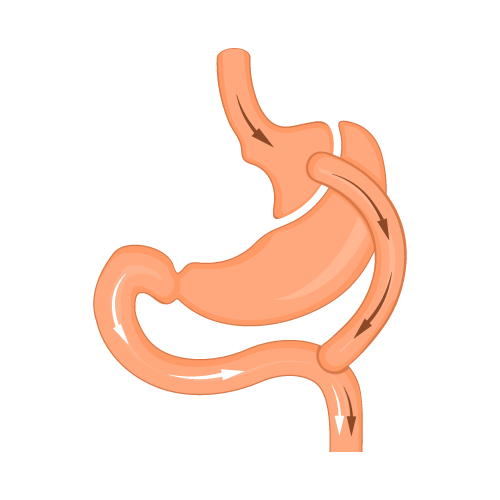Laparoscopic Roux en Y Gastric Bypass
Roux-en-Y gastric bypass (RYGB) is a weight-loss surgery for those who have failed to achieve weight loss through non-surgical options like diet and exercise. The procedure involves creating a small pouch at the top of your stomach and attaching a section of your small intestine to this new pouch. This allows food to bypass the rest of your stomach and part of your small intestine, reducing the calories and nutrients your body absorbs.
The procedure
The procedure is done under general anesthesia and needs hospital admission for two days or more. Even though it is done as a minimal-access surgery, it requires preparation from the medical team and the patient. After thoroughly assessing your general health, weight loss goals, and hormonal profile with physical medical tests and imaging, the doctor will suggest the correct type of bariatric surgery for you.
This surgery is done through several small incisions in your abdomen. A laparoscope (a thin, lighted tube) is inserted through one of these incisions. The surgeon uses the laparoscope to see inside your abdomen and operate.
Surgeons performing the laparoscopic roux en Y gastric bypass will use a laparoscopic stapler to create a small pouch in the upper part of your stomach. The remaining part of your stomach is then disconnected from this pouch and won’t be able to hold as much food.
Next, the surgeon will divide the upper part of your small intestine into a tube with two ends. One end of the small intestine (the Roux limb) is brought up and attached to the stomach pouch. A small connection (anastomosis) is made between the Roux limb and the stomach pouch.
This new connection allows food to bypass a large portion of your small intestine, so you absorb fewer calories and lose weight.


Risks, recovery, and aftercare
Roux-en-Y gastric bypass surgery risks include infection, bleeding, and blood clots. You may also experience “dumping syndrome”, when food moves too quickly from your stomach to your small intestine, causing nausea, vomiting, diarrhea, and dizziness.
Most people who have Roux-en-Y gastric bypass surgery lose a significant amount of weight. Studies have shown that people who have this surgery can expect to lose 50-60% of their excess body weight within the first year after surgery. However, it’s important to note that weight loss surgery is not a quick fix. It’s a tool that can help you make long-term changes to your eating and exercise habits.
Although the initial weight loss may be rapid, you may need to supplement with multivitamins, calcium, iron, and vitamin D to maintain optimal nutrient levels. You can achieve and keep your health goals with regular follow-ups with your doctor and surgeon and with a dietician’s help.
If you’re considering Roux-en-Y gastric bypass surgery, it’s important to consult with a board-certified bariatric surgeon to discuss the risks and benefits of the procedure. If you are advised to have a Laparoscopic Roux en Y gastric bypass, you will need to be prepared psychologically as well for the lifestyle change.
